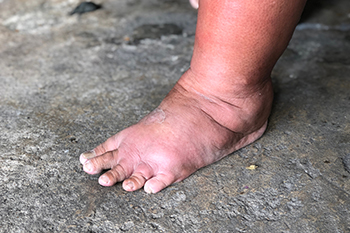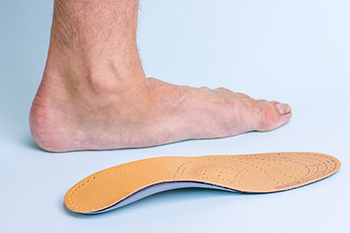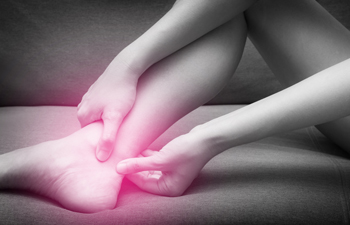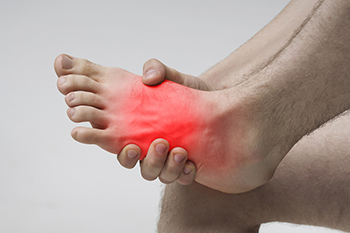Middlefield (860) 349-8500
Wallingford (203) 294-4977
Middlefield (860) 349-8500
Wallingford (203) 294-4977

Our feet are like workhorses in the body. We depend on them daily, but sometimes they swell up. The most common cause of swollen feet is a buildup of fluids, usually around the ankle. This is a common occurrence among pregnant women. Other causes of swollen feet are simply being on them too much, and the reverse, being too sedentary. Poor circulation, or a foot or ankle injury also can cause swelling. Being overweight can cause your feet to become swollen. Sometimes hormonal changes can cause a buildup of fluids, which may lead to swelling. Infections caused by diabetic neuropathy can also result in swollen feet, along with other problems. Cutting back on salt, resting the feet, and keeping them elevated can help reduce swelling. If it continues or becomes worse, it is a good idea to consult a podiatrist for a complete examination and treatment options.
Everyday foot care is very important to prevent infection and other foot ailments. If you need your feet checked, contact Dr. Gordon Fosdick from Affiliated Foot Care Center. Our doctor can provide the care you need to keep you pain-free and on your feet.
Everyday Foot Care
Often, people take care of their bodies, face and hair more so than they do for their feet. But the feet are a very important aspect of our bodies, and one that we should pay more attention to. Without our feet, we would not be able to perform most daily tasks.
It is best to check your feet regularly to make sure there are no new bruises or cuts that you may not have noticed before. For dry feet, moisturizer can easily be a remedy and can be applied as often as necessary to the affected areas. Wearing shoes that fit well can also help you maintain good foot health, as well as making it easier to walk and do daily activities without the stress or pain of ill-fitting shoes, high heels, or even flip flops. Wearing clean socks with closed shoes is important to ensure that sweat and bacteria do not accumulate within the shoe. Clean socks help to prevent Athlete’s foot, fungi problems, bad odors, and can absorb sweat.
If you have any questions please feel free to contact our offices located in Middlefield and Wallingford, CT . We offer the newest diagnostic and treatment technologies for all your foot and ankle needs.

Many people are born with flat feet. Some live a healthy, active lifestyle with little to no pain from this condition while others are subject to chronic foot and leg pain. With normal walking, the foot flattens slightly to absorb force and to help accommodate the surface being walked on. A flat foot allows flexibility compared to a foot that has a higher arch, it is locked and rigid and does not absorb the force or mold to the ground. However, because a flat foot is looser, it can be prone to chronic muscle strain because the muscles work harder to keep the foot in a stable position. While the body can adapt to flat feet, when there is an increase or change in intensity or duration of an activity, pain may result. A flat foot can also trigger the inward rotation of the lower leg bone (the tibia), which causes the knees to point inward. Since the upper leg bone will generally follow this movement along, the leg, hip, and lower back may become affected. It is important to know whether you were born with flat feet or if they are caused by something else. A podiatrist can help you figure this out and if you are in pain, provide suggestions and treatment on what can be done to increase your comfort.
Flatfoot is a condition many people suffer from. If you have flat feet, contact Dr. Gordon Fosdick from Affiliated Foot Care Center. Our doctor will treat your foot and ankle needs.
What Are Flat Feet?
Flatfoot is a condition in which the arch of the foot is depressed and the sole of the foot is almost completely in contact with the ground. About 20-30% of the population generally has flat feet because their arches never formed during growth.
Conditions & Problems:
Having flat feet makes it difficult to run or walk because of the stress placed on the ankles.
Alignment – The general alignment of your legs can be disrupted, because the ankles move inward which can cause major discomfort.
Knees – If you have complications with your knees, flat feet can be a contributor to arthritis in that area.
Symptoms
Treatment
If you are experiencing pain and stress on the foot you may weaken the posterior tibial tendon, which runs around the inside of the ankle.
If you have any questions please feel free to contact our offices located in Middlefield and Wallingford, CT . We offer the newest diagnostic and treatment technologies for all your foot and ankle needs.

The large tendon located in the back of the calf is known as the Achilles tendon. It plays an important role in pointing and flexing the foot which is vital to completing daily activities. An Achilles tendon injury can occur for several reasons. These can include sustaining a running or jumping injury, changing an exercise routine, or wearing shoes that do not fit correctly. There may be existing medical conditions that lead to this painful foot condition, including obesity, having flat feet, or if your foot rolls inward while walking or running. The symptoms that are often associated with this type of injury can consist of intense pain at the time of the injury and stiffness, and the affected area is often swollen. Some patients even hear a popping noise as the injury occurs and this generally requires immediate medical attention. There are different methods to treat this condition and it is strongly suggested that you are under the care of a podiatrist who can determine which treatment is best for you.
Achilles tendon injuries need immediate attention to avoid future complications. If you have any concerns, contact Dr. Gordon Fosdick of Affiliated Foot Care Center. Our doctor can provide the care you need to keep you pain-free and on your feet.
What Is the Achilles Tendon?
The Achilles tendon is a tendon that connects the lower leg muscles and calf to the heel of the foot. It is the strongest tendon in the human body and is essential for making movement possible. Because this tendon is such an integral part of the body, any injuries to it can create immense difficulties and should immediately be presented to a doctor.
What Are the Symptoms of an Achilles Tendon Injury?
There are various types of injuries that can affect the Achilles tendon. The two most common injuries are Achilles tendinitis and ruptures of the tendon.
Achilles Tendinitis Symptoms
Rupture Symptoms
Treatment and Prevention
Achilles tendon injuries are diagnosed by a thorough physical evaluation, which can include an MRI. Treatment involves rest, physical therapy, and in some cases, surgery. However, various preventative measures can be taken to avoid these injuries, such as:
If you have any questions please feel free to contact our offices located in Middlefield and Wallingford, CT . We offer the newest diagnostic tools and technology to treat your foot and ankle needs.

The foot consists of 34 joints, all of which contain synovial membranes. When these membranes become inflamed, the result is swelling, redness, and pain when you move. This condition, known as synovitis, is common among athletes who are involved in repetitive stress movements like lifting and squatting. Patients with rheumatoid arthritis, juvenile arthritis, lupus, and psoriatic arthritis may also experience synovitis. In these cases, excessive growth of the synovial membrane is part of an autoimmune response where the body attacks itself. The cells then release enzymes into the synovial capsule of the joint causing further inflammation and pain. Depending on the cause, pain from synovitis can be short-lived or continued. If you are experiencing frequent joint pain or inflammation of the feet and ankles, it is suggested to check with a podiatrist for a complete examination and proper diagnosis.
Because RA affects more than just your joints, including the joints in your feet and ankles, it is important to seek early diagnosis from your podiatrist if you feel like the pain in your feet might be caused by RA. For more information, contact Dr. Gordon Fosdick of Affiliated Foot Care Center. Our doctor will assist you with all of your podiatric concerns.
What Is Rheumatoid Arthritis?
Rheumatoid Arthritis (RA) is an autoimmune disorder in which the body’s own immune system attacks the membranes surrounding the joints. Inflammation of the lining and eventually the destruction of the joint’s cartilage and bone occur, causing severe pain and immobility.
Rheumatoid Arthritis of the Feet
Although RA usually attacks multiple bones and joints throughout the entire body, almost 90 percent of cases result in pain in the foot or ankle area.
Symptoms
Diagnosis
Quick diagnosis of RA in the feet is important so that the podiatrist can treat the area effectively. Your doctor will ask you about your medical history, occupation, and lifestyle to determine the origin of the condition. Rheumatoid Factor tests help to determine if someone is affected by the disease.
If you have any questions please feel free to contact our offices located in Middlefield and Wallingford, CT . We offer the newest diagnostic and treatment technologies for all your foot and ankle needs.